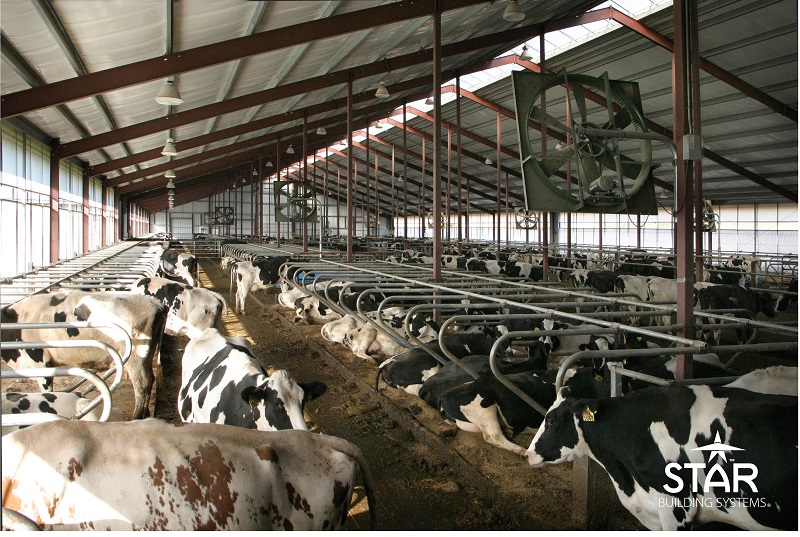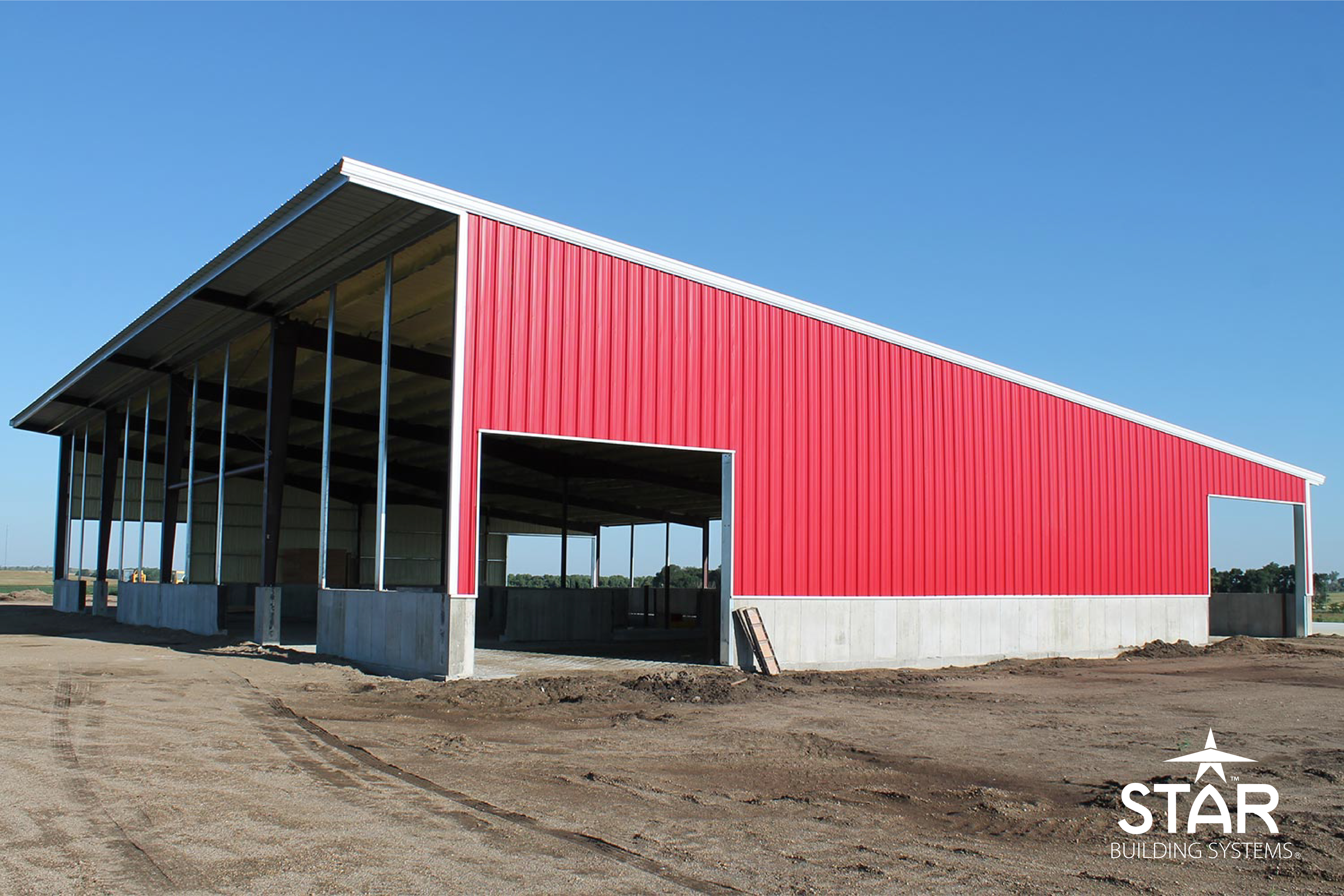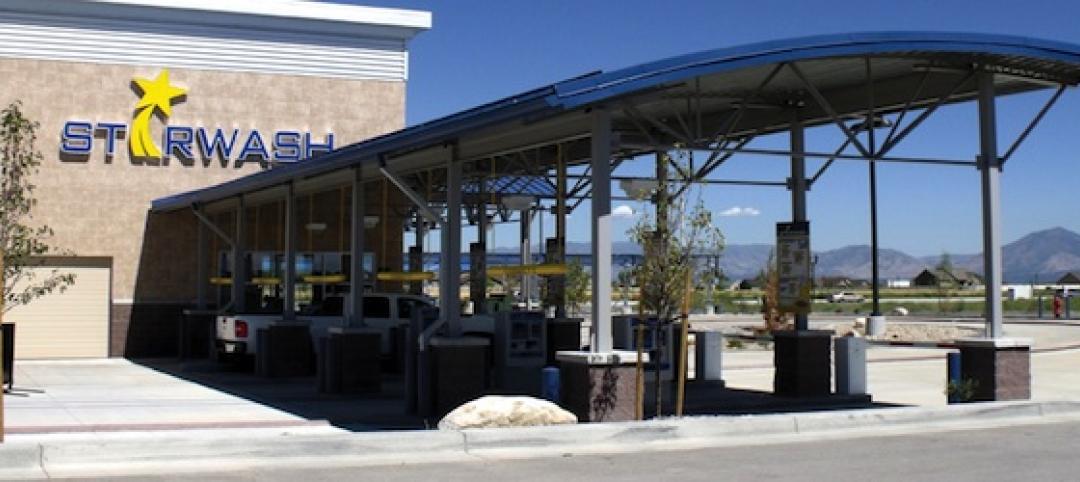Working farms and ranches need facilities that can stand up to corrosive animal waste, hot summers, harsh winters and provide proper storage for equipment, livestock, feed and more. Metal buildings provide numerous advantages to the agricultural marketplace with their many uses – and benefits. They meet typical industry standards of maximum storage space, maneuverability and protection. Star Building Systems has been providing custom-engineered metal building systems to the agriculture industry for years. Star buildings are also compatible with any conventional exterior, allowing for customized aesthetic designs that stand up to the wear and tear of their environments.
 Cobalt Stables combined horse stables and training facilities with a human residence – all under one roof. Learn more.
Cobalt Stables combined horse stables and training facilities with a human residence – all under one roof. Learn more.
Benefits to the Agricultural Industry
Durability: Your agriculture building is an investment – it needs to work now, and for decades to come. Metal buildings are sturdier than traditional buildings, withstanding harsh weather conditions such as strong winds, heavy snow, thunderstorms and extreme temperatures. They are also NOT susceptible to the same type of damage that wood buildings endure, such as termite, carpenter ant or other insect damage.
Efficiency: Steel buildings provide an enormous amount of storage space, depending upon needs, for supplies, animals, feed and equipment, also allowing for a multitude of interior options for aisles, horse stalls or even additional rooms. Star routinely designs agricultural and livestock facilities that include light transmitting panels and lofts for added storage space. Our design approach allows for high ceilings, helping to promote proper ventilation to clear the air of dust and mold in bedding, hay and feed.
Low Maintenance: Overall, metal buildings require less maintenance than buildings constructed with traditional materials. This allows building owners to save money throughout the life of the building, reducing operating budgets.
Fire Resistance: Steel provides a non-flammable and non-combustible material and compared to wood, it is eligible for various construction types under different building codes.
Cost Effectiveness: High operating costs for a farm or ranch means that saving on long-term expenditures is an important part of making efficient construction choices. Star buildings are custom engineered and designed to meet all requirements, as well as local building codes. Future maintenance and energy cost considerations receive major attention and performance-proved quality materials used in the manufacturing process insure savings on future upkeep and maintenance costs.
Clear Spans: Maneuvering large and cumbersome equipment can be tricky if your structure is not able to fully accommodate varying machinery sizes. Wood-framed buildings and steel arch-style structures are limited in their structural widths and wood pole barns require interior columns to support the structural load. Custom-engineered metal buildings are strong – and can span up to 300’ in width without interior columns. This is a huge benefit for large livestock buildings, indoor or covered arenas and product storage shelters.
Design and Customization Options: Depending upon the operation, buildings will need to be customized – and Star Building Systems excels in customization. Different agriculture structures will require different doorways. Some may need overhead doors, personnel doors or windows. Floors may be dirt, gravel, asphalt, concrete, brick, rubber brick or mats, accommodating any special drainage requirements that may be needed for efficient building use. Recessed spaces the in the aisles for water faucets, easy to clean wall finishes and maximum roof lighting are all features that a Star building can easily accommodate.
Environmentally Friendly: Farmers and ranchers know what it means to work and respect the land. Focus is on sustainability and being a good steward of the environment. Steel is the most recycled material in the world and Star’s metal buildings are produced with materials that are 99% recyclable. Sun reflective color options are also available for roof panels in order to minimize the absorption of heat into the building.
Mitigate Livestock Corrosion: Animal waste creates a highly aggressive environment, fostering corrosion that can damage steel wall and roof panels, despite their durability and strengths. However, Star buildings have been found to successfully mitigate these challenges by using a combination of smart building designs, incorporating proper ventilation into the building and having the correct corrosion-resistant materials included on their wall and roof panels.
 Housing livestock can be a challenge to the integrity of a building; however, with Star, that challenge can be met. Learn more.
Housing livestock can be a challenge to the integrity of a building; however, with Star, that challenge can be met. Learn more.
Livestock and agricultural buildings from Star Building Systems offer optimal efficiency and performance. With nearly a century of experience and over 300,000 satisfied customers, the Star buildings team can provide information about site selection, topographic conditions and interior & exterior design to meet any long-term objective, no matter the size or scope of the project. To learn more about how Star Building Systems can help you become a leader in the metal building industry, visit www.starbuildings.com.
Related Stories
| Mar 10, 2011
Steel Joists Clean Up a Car Wash’s Carbon Footprint
Open-web bowstring trusses and steel joists give a Utah car wash architectural interest, reduce its construction costs, and help green a building type with a reputation for being wasteful.
| Mar 8, 2011
ThyssenKrupp Nirosta, Christian Pohl GmbH supply stainless steel to One World Trade Center
Corners of the One World Trade Center 's facade will be edged with stainless steel made in Germany. ThyssenKrupp Nirosta (Krefeld) produced the material at its Dillenburg plant using a customized rolling and heat-treatment process. Partner company Christian Pohl GmbH (Cologne) fabricated the material into complex facade elements for the corners of the New York City skyscraper.
| Feb 22, 2011
Military tests show copper increases HVAC efficiency, reduces odors
Recent testing, which is being funded by the Department of Defense, is taking place in military barracks at Fort Jackson, South Carolina. Side-by-side comparisons demonstrate that air conditioning units made with copper suppress the growth of bacteria, mold, and mildew that cause odors and reduce system energy efficiency.
| Dec 17, 2010
Gemstone-inspired design earns India’s first LEED Gold for a hotel
The Park Hotel Hyderabad in Hyderabad, India, was designed by Skidmore, Owings & Merrill to combine inspirations from the region’s jewelry-making traditions with sustainable elements.
| Dec 7, 2010
Product of the Week: Petersen Aluminum’s column covers used in IBM’S new offices
IBM’s new offices at Dulles Station West in Herndon, Va., utilized Petersen’s PAC-1000 F Flush Series column covers. The columns are within the office’s Mobility Area, which is designed for a mobile workforce looking for quick in-and-out work space. The majority of workspaces in the office are unassigned and intended to be used on a temporary basis.
| Nov 5, 2010
New Millennium’s Gary Heasley on BIM, LEED, and the nonresidential market
Gary Heasley, president of New Millennium Building Systems, Fort Wayne, Ind., and EVP of its parent company, Steel Dynamics, Inc., tells BD+C’s Robert Cassidy about the Steel Joist Manufacturer’s westward expansion, its push to create BIM tools for its products, LEED, and the outlook for the nonresidential construction market.
| Oct 11, 2010
MBMA Releases Fire Resistance Design Guide for metal building systems
The Metal Building Manufacturers Association (MBMA) announces the release of the 2010 Fire Resistance Design Guide for Metal Building Systems. The guide provides building owners, architects, engineers, specifiers, fire marshals, building code officials, contractors, product vendors, builders and metal building manufacturers information on how to effectively meet fire resistance requirements of a project with metal building systems.
| Sep 13, 2010
7 Ways to Economize on Steel Buildings
Two veteran structural engineers give you the lowdown on how to trim costs the next time you build with steel.
| Aug 11, 2010
AAMA leads development of BIM standard for fenestration products
The American Architectural Manufacturers Association’s newly formed BIM Task Group met during the AAMA National Fall Conference to discuss the need for an BIM standard for nonresidential fenestration products.












